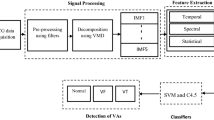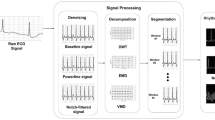Abstract
This study presents a new very low frequency (VLF) band range in ventricular tachyarrhythmia patients and involves an approach for estimation of effect of VLF band on ventricular tachyarrhythmia patients. A model based on wavelet packets (WP) and multilayer perceptron neural network (MLPNN) is used for determination of effective VLF band in heart rate variability (HRV) signals. HRV is decomposed into sub-bands including very low frequency parts and variations of energy are analyzed. Domination test is done using MLPNN and dominant band is determined. As a result, a new VLF band was described in 0.0039063–0.03125 Hz frequency range. This method can be used for other bands or other arrhythmia patients. Especially, estimation of dominant band energy using this method can be helped to diagnose for applications where have important effect of characteristic band.




Similar content being viewed by others
References
Task force of the European society of cardiology and the North American society of pacing and electrophysiology, Heart rate variability-standards of measurement, physiological interpretation, and clinical use. Circulation. 93:1043–1065, 1996.
Acharya, U. R., Joseph, K. P., Kannathal, N., Lim, C. M., and Suri, J. S., Heart rate variability: a review. Med. Bio. Eng. Comput. 44:1031–1051, 2006.
Chen, S. W., A wavelet based HRV analysis for the study of nonsustained ventricular Tachycardia, IEEE transactions on biomedical engineering, Vol:49, No:7, 2002.
Malarvili, M. B., Mesbah, M., Boashash, B., Time-frequency analysis of heart rate variability for Neonatal Seizure detection. EURASIP Journal on Advances in Signal Processing, Vol:2007, Article ID: 50396, pp. 10., 2007. doi:10.1155/2007/50396.
Shafqat, K., Pal, S. K., Kumari, S., and Kyriacou, P. A., Changes in heart rate variability in patients under local Anesthesia. Proceedings of the 29th Annual International Conference of IEEE EMBSLyon: France, 2007.
Hossen, A., Ghunaimi, B. A., and Hassan, M. O., Subband decomposition soft-decision Algorithm for heart rate variability analysis in patients with obstructive sleep Apnea and normal controls. Signal Processing. 85:95–106, 2005.
Morris, F., Edhouse, J., Brady, W. J., Camm, J., ABC OF Clinical Electrocardiography, BMJ Books, First published in 2003, by BMJ Books, BMA House, Tavistock Square, London WC1H 9JR.
Bilgin, S., Colak, O. H., Koklukaya, E., and Ari, N., Efficient solution for frequency band decomposition problem using wavelet packet for HRV. Digital Signal Processing. 18:892–299, 2008. doi:10.1016/j.dsp.2008.04.007.
Addison, P. S., The Illustrated Wavelet Transform Handbook: Introductory Theory and Applications in Science, Engineering, Medicine and Finance, IOP Publishing Ltd, 2002.
Park, J.-W., Harley, R. G., and Venayagamoorthy, G. K., Comparison of MLP and RBF neural networks using deviation signals for on-line identification of a synchronous generator. Power Engineering Society Winter Meeting. 1:274–279, 2002.
Lera, G., and Pinzolas, M., A quasi-local Levenberg-Marquardt algorithm for neural network training neural networks proceedings. IEEE World Congress on Computational Intelligence, The 1998 IEEE International Joint Conference. 3:2242–2246, 1998.
Acknowledgments
The research has been supported by the Research Project Department of Akdeniz University, Antalya, Turkey. This study is a part of studies held by Akdeniz University Industrial and Medical Applications Microwave Research Center (IMAMWRC), signal and image processing laboratory and University of Technology Zurich, Department of R&D.
Author information
Authors and Affiliations
Corresponding author
Rights and permissions
About this article
Cite this article
Bilgin, S., Çolak, O.H., Polat, O. et al. Determination of a New VLF Band in HRV for Ventricular Tachyarrhythmia Patients. J Med Syst 34, 155–160 (2010). https://doi.org/10.1007/s10916-008-9227-8
Received:
Accepted:
Published:
Issue Date:
DOI: https://doi.org/10.1007/s10916-008-9227-8




